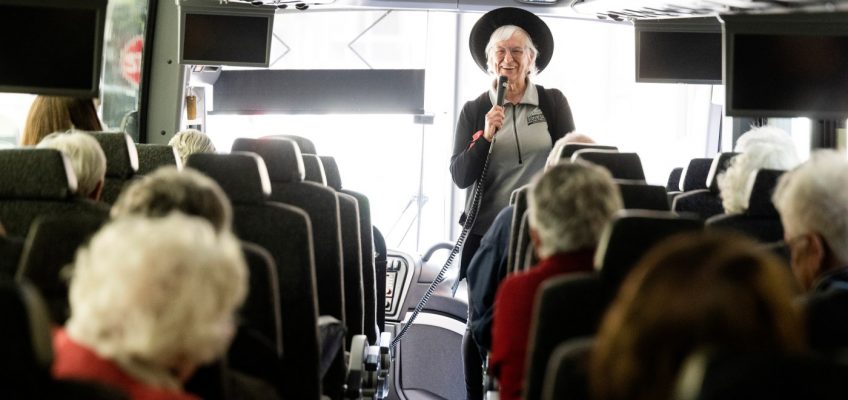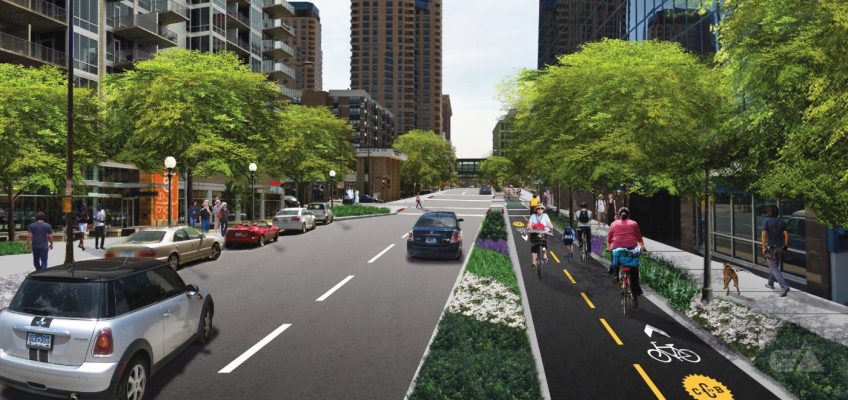Sandy Mansee’s tour groups have been to Bayfield, Chicago, St. Louis, Fargo and Sioux Falls.
They’ve toured the Field of Dreams in Dyersville, Iowa; Ulysses S. Grant’s house in Galena, Ill.; the Spam Museum in Austin, Minn.; and the Orphanage Museum in Owatonna. They’ve learned how candles, paint, pillows, mattresses, cardboard boxes, cement trucks, windows and baked beans are made.
“I like to learn things,” said Mansee, a tour guide for the St. Paul Public Schools Community Education program. “I’ve always been curious. I like to go to new places, and it’s always fun to go to places where the general public can’t go. There’s so much to see right in our back yard.”
Now, after more than 33 years and 300 tours, Mansee is giving up her microphone and the front seat of the bus. On Thursday, Mansee, 64, of Vadnais Heights, led her last tour for Community Education; she retires on May 30.
“It’s a special day,” said Mansee, as she greeted the 22 participants on the bus Thursday morning outside Oxford Community Center in St. Paul. “This will be my last bus tour after 33 years of working with St. Paul Community Education. … We’re going to have a great day. Please ask questions. You guys usually have questions.”
The tour participants — each of whom paid $65 for the day — joined Mansee for a guided tour of St. Paul City Hall and the Ramsey County Courthouse in downtown St. Paul, lunch on their own at Rosedale Center in Roseville, and a tour of the “On + Off Weaving” exhibit and a “behind-the-scenes look” at the Dye Lab and Dye Garden at the Textile Center in Minneapolis.
Although they couldn’t go on Thursday’s tour, longtime tour participants Ron and Marghe Tabar stopped by to give Mansee a hug and wish her a happy retirement. “We’ve been lucky to have Sandy as our tour guide all these years,” Marghe Tabar said. “She’s cheerful and well-organized. She is clear of her expectations of those on the bus. The tour days run on time, and she’s done her research.”
The couple has enjoyed — “and bragged about” — Mansee’s “Made in Minnesota” tours for many years, Marghe Tabar said.
“I’ve kept a list of most of the tours because sometimes the places we visited are unusual locations to take visitors,” she said. “Somehow she talks business owners into opening their doors to groups.”
Some of the Tabars’ favorites include: QBP (Quality Bicycle Products); the MyPillow factory; the Original Mattress Factory; Captain Ken’s Baked Beans factory; WestRock, the corrugated packaging company; Tilsner Carton Co.; Podiumwear Custom Sports Apparel; the Schwing factory, maker of truck-mounted concrete pumps; Andersen Windows; a hydroponics factory that grew fish and herbs; TruStone Coffee Roasters; Vistabule Teardrop Trailers; Minnesota Knitting Mills; BEKA Wood Products; and the U.S. Postal Service mail distribution site in Eagan.
Mishaps and Mystery Tours
Mansee organizes everything and does her research, said Rita Jondahl, 75, of St. Paul. “She knows everything, and she makes it fun. It’s nice because there are always other people around, even if you’re by yourself.”
Jeanne Driscoll, 73, of St. Paul, has taken 16 of Mansee’s tours. Her favorite tours are Mansee’s “Mystery Tours” — the ones where Mansee picks the locations, but tour participants have no idea where they are going until they get on the bus.
Mansee, whose official title is Community Education program coordinator, said she especially loved planning the Mystery Tours. “I’d plan the day, set the price, and people would sign up,” she said. “They’d have no idea where they were going. When they boarded the bus, they just trusted me to take them on an adventure.”
One of the best Mystery Tour destinations was a trip to the Minnesota Highway Safety & Research Center in St. Cloud, she said. “They actually let us drive their training course and drive the (Minnesota State Patrol) trooper cars around the track and run the sirens and the whole deal. Everybody who wanted to drive got to drive the course and be in the driver’s seat of a trooper’s car. They loved it.”
There have been some mishaps, of course. Buses have broken down. One bus driver refused to help with the luggage. Trips have had to be postponed because of bad weather. Passengers have gotten sick. Some haven’t understood the concept of being back at the bus at a set time.
Sandy Mansee, holding her signature straw hat, asks for people to gather around during a tour of the St. Paul City Hall and Ramsey County Courthouse. (John Autey / Pioneer Press)
Once, during a visit to the Island of Happy Days, a historic estate on Stout Island in Wisconsin, tour participants were served beef stroganoff for lunch, Mansee said. “It was so slippery that we could barely pick it up with our forks. You had to use your fork and your spoon, and hope you got it to your mouth. Every time I see anybody who was on that tour, we still talk about that.”
Mansee once lost her voice on an overnight trip to Duluth — a major obstacle for a tour guide, she said.
Related Articles
Beyond the Paris Olympics: Other intriguing events set throughout France this year
How you can prioritize debt and still take a vacation
Travel: Charming Georgia town a treat for ‘Flanatics’ of celebrated Southern writer O’Connor
Travel: After 5 years of closure, ‘glamping’ back again in Yosemite National Park
Survey: More than 1 in 3 American travelers plan to go into debt for their summer vacations this year
“This was back when the (St. Paul) Saints were at the Midway Stadium,” she said. “They were still very new, and you couldn’t get a ticket for all you were worth. I would take a trip to see the Saints once a season. … We would travel to support them, and then I’d fill it out with other locations along the way. We were at the Duluth game to see the Dukes one time, and we were having a great time, and it was megaphone night, so we all got free megaphones. I started cheering for the Saints. Well, there were some Duke fans across the aisle, and they were cheering for the Dukes, and we cheered so hard, I woke up the next morning, and I had no voice. It was so funny.”
Yes, Mansee said, she is supposed to talk on her trips.
“All I could do was squeak, but they laughed at me, and they just thought it was the best,” she said. “People thought it was hilarious that I enjoyed my job and I screamed and supported them so much.”
‘Enriching lives’
Mansee’s enthusiasm is infectious, said Katy Mommaerts, community programs supervisor for Community Education. Mommaerts served as Mansee’s direct supervisor for six years.
“Sandy will not plan something that she is not willing to do herself,” she said. “She will zipline, fly on a trapeze, whatever it takes.”
In addition to organizing bus tours, Mansee was responsible for coordinating Community Education’s walking tours, business and technology classes, and the 55-plus discount driving classes.
“Sandy has just been such a gift to Community Ed,” Mommaerts said. “She’s committed to the mission of enriching lives, of trying to make people feel excited about things in their community they don’t know about. It’s hard to imagine her not being here.”
Mansee grew up in Hartland, Wis., outside of Milwaukee, and graduated from the University of Wisconsin-La Crosse in 1981 with a bachelor’s degree in recreation. She and her husband, Mark, have two sons.
Prior to joining Community Education in October 1990, Mansee worked in senior programming at Capital Community Services, which later merged with Keystone Community Services, and was the activities director at Episcopal Homes in St. Paul. “I did card clubs and exercise classes and craft activities,” she said. “I organized outings and lunches and took people walking. Not only did I organize exercise classes, I taught them.”
She organized her first tour for Community Education in the fall of 1991; the group went to the Grain Exchange and the Federal Reserve Bank of Minneapolis and had lunch at City Center, she said. “We went to Stockholm (Wis.) that winter and did a Christmas lights tour along the Mississippi River, and we had dinner at the Stockholm Cafe. Early on, we went up to Mille Lacs and did a fishing tour.”
It’s easy to spot Mansee in a crowd during a tour. She’s the one wearing a straw hat covered with dozens of enamel pins she’s collected while traveling with Community Education. Among the locations featured: Pipestone, Galena, Ashley Furniture, Al Capone’s Hideout, the St. Louis Arch, Door County, Wisconsin Dells, the Music Man Square, and the Edmund Fitzgerald Memorial.
“They can always pick me out of a crowd,” she said. “When we go to a venue, and they say, ‘Who’s in charge?’ they all go, ‘The lady in the hat.’ I love wearing hats, so I always wear this one.”
Sandy Mansee takes a picture of the 36-foot tall “Visions of Peace” statue, reflected in a marble column, while guiding a tour of St. Paul City Hall and the Ramsey County Courthouse. Mansee is retiring on May 30. (John Autey / Pioneer Press)
What makes for a good tour guide? “You’ve got to make sure everybody feels welcome and included, and you give that extra TLC,” Mansee said. “It helps if you are well organized ahead of time, trying to foresee all of the things that can or could happen. You can’t head them all off, but it’s so much easier now, compared to in the early years, because now we have cellphones, and we have texting, and we have email.
“Back when I first started leading tours, we didn’t have any of that, so when I was running behind, there was no way to reach destinations and say, ‘I’m coming, but I’m half an hour late.’ You just winged it and hoped for the best. Technology has helped a lot in that regard.”
Tour guides can’t foresee bad weather or road construction or bus breakdowns, “so you just have to be open-minded and go with the flow,” she said. “Sometimes you just have to bite your tongue because we’ve all had locations that didn’t pan out to be what you thought, or they had the time wrong, or I had the time wrong, so things can get a little wonky sometimes.”
Gerhard and Mary Jane Keilen, who went on numerous tours with Mansee through the years, said they were sad to say goodbye to her on Thursday.
“She explains everything in detail,” Gerhard Keilen said. “She’s just fantastic.”
“She’s so personable,” said Mary Jane Keilen. “She knows everybody by name. She’s so informative, and she researches everything. She’s fun, she’s patient, and she finds us the most interesting places to see. They enlighten your mind and bring a song to your heart.”
St. Paul Community Education tours
Yes, St. Paul Community Education plans to continue offering tours after Sandy Mansee retires.
Information about the tours can be found in the “Trips and Travelogues” section of its catalog.
For more information, go to commed.spps.org.
Related Articles
Movie review: ‘Challengers’ sizzles with bubbling ferocity
Homshuk in Apple Valley features soulful, authentic Mexican food
Annual Stillwater plant sale set for May 18
Movie review: Don’t expect a coherent story from ‘Downtown Owl’
World Tai Chi Day in Stillwater to feature debut of traditional Chinese dancing dragon




